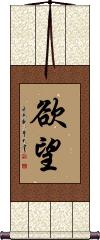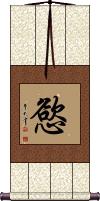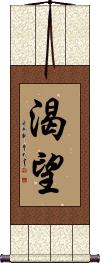Many custom options...
And formats...

Desire Craving in Chinese / Japanese...
Buy a Desire Craving calligraphy wall scroll here!
Personalize your custom “Desire Craving” project by clicking the button next to your favorite “Desire Craving” title below...
Desire / Craving
欲望 is a word that means strong desire, while some might translate it as “lust.”
The first character of this word means desire, longing, hunger, covetousness, greed, passion, desire, craving, or wish. The second character means to hope for, ambition, desire, aspire, expect, gaze (into the distance), or look for something.
Desire / Longing / Craving
慾 means desire, longing, appetite, wish, covetousness, greed, passion, desire, avarice, and craving.
慾 is universal in Chinese, Japanese Kanji, and Korean Hanja.
The context in which this character is used determines whether the meaning is good or bad. As a single character on a wall scroll, you get to decide what the definition is to you (hopefully more toward desire than greed).
![]() Please note that Japanese use a simplified version of this character - it also happens to be the same simplification used in mainland China. Click on the character to the right if you want the Japanese/Simplified version of desire.
Please note that Japanese use a simplified version of this character - it also happens to be the same simplification used in mainland China. Click on the character to the right if you want the Japanese/Simplified version of desire.
Lust / Desire / Passion
情欲 can be defined as lust, sexual desire, sensual desire, carnal desire, carnal passions, sexual desire, and passion.
The first character means feeling, emotions, passionate, sympathy, affection, love, compassion, tender feelings, and sometimes circumstances or facts.
The second character means desire, longing, appetite, wish, covetousness, greed, passion, desire, and craving.
This word is universal in Chinese, Japanese Kanji, and Korean Hanja.
Desire
This Chinese word can mean desirous, wishful, or desire.
The first character means to thirst for [something] or to be thirsty. The second character means to hope for, to expect, to gaze (into the distance), or to look for something. The combined meaning of these two characters changes a bit, but I think it's nice to know the individual meanings to give you a better understanding of where a word comes from.
Korean definitions of this word include craving, longing, and thirst for knowledge.
Not the results for Desire Craving that you were looking for?
Below are some entries from our dictionary that may match your Desire Craving search...
| Characters If shown, 2nd row is Simp. Chinese |
Pronunciation Romanization |
Simple Dictionary Definition |
愛 爱 see styles |
ài ai4 ai rui るい |
More info & calligraphy: Love(n,n-suf) (1) (See 愛する) love; affection; care; (2) {Buddh} attachment; craving; desire; (3) {Christn} (See アガペー・1) agape; (4) (abbreviation) Ireland; (female given name) Rui kāma; rāga. Love, affection, desire; also used for tṛṣṇā, thirst, avidity, desire, one of the twelve nidānas. It is intp. as 貪 coveting, and 染著 defiling attachment; also defined as defiling love like that toward wife and children, and undefiling love like that toward one's teachers and elders. |
慾 欲 see styles |
yù yu4 yü yoku よく |
More info & calligraphy: Desire / Longing / Cravinggreed; craving; desire; avarice; wants Passion, inordinate desire, lust, v. 欲. |
欲 see styles |
yù yu4 yü yoku よく |
More info & calligraphy: Desire / Longing / Cravinggreed; craving; desire; avarice; wants; (surname) Yoku rājas, passion. Also kāma, desire, love. The Chinese word means to breathe after, aspire to, desire, and is also used as 慾 for lust, passion; it is inter alia intp. as 染愛塵 tainted with the dust (or dirt) of love, or lust. The three desires are for beauty, demeanour, and softness; the five are those of the five physical senses. |
貪 贪 see styles |
tān tan1 t`an tan tan; ton; don たん; とん; どん |
to have a voracious desire for; to covet; greedy; corrupt (1) coveting; (2) {Buddh} (usu. とん) raga (desire) rāga; colouring, dyeing, tint, red; affection, passion, vehement longing or desire; cf. M. W. In Chinese: cupidity, desire; intp. tainted by and in bondage to the five desires; it is the first in order of the 五鈍使 pañca-kleśa q. v., and means hankering after, desire for, greed, which causes clinging to earthly life and things, therefore reincarnation. |
垂涎 see styles |
chuí xián chui2 xian2 ch`ui hsien chui hsien suizen; suien; suisen(ok) すいぜん; すいえん; すいせん(ok) |
to water at the mouth; to drool (n,vs,vi) (1) avid desire; craving; thirst; envy; (n,vs,vi) (2) (orig. meaning) watering at the mouth; drooling |
心願 心愿 see styles |
xīn yuàn xin1 yuan4 hsin yüan shingan しんがん |
cherished desire; dream; craving; wish; aspiration prayer; heartfelt wish The will of the mind, resolve, vow. |
慾望 欲望 see styles |
yù wàng yu4 wang4 yü wang yokubou / yokubo よくぼう |
desire; longing; appetite; craving (irregular kanji usage) desire; appetite; lust |
欲情 see styles |
yù qíng yu4 qing2 yü ch`ing yü ching yokujou / yokujo よくじょう |
(noun/participle) passion; passions; (sexual) desire; craving passion |
欲求 see styles |
yù qiú yu4 qiu2 yü ch`iu yü chiu yokkyuu / yokkyu よっきゅう |
to desire; wants; appetites (noun, transitive verb) desire; want; will; wish; urge; craving desire, craving, aspiration |
欲貪 欲贪 see styles |
yù tān yu4 tan1 yü t`an yü tan yokuton |
Desire and coveting, or coveting as the result of passion; craving. |
渇愛 渇爱 see styles |
kě ài ke3 ai4 k`o ai ko ai katsuai かつあい |
thirst; craving; desire thirst |
物欲 see styles |
wù yù wu4 yu4 wu yü butsuyoku ぶつよく |
material desire; craving for material things greed; worldly or materialistic desires |
生願 生愿 see styles |
shēng yuàn sheng1 yuan4 sheng yüan |
desire to exist (in Buddhism, tanhā); craving for rebirth |
苦集 see styles |
kǔ jí ku3 ji2 k`u chi ku chi ku shu |
samudaya, arising, coming together, collection, multitude. The second of the four axioms, that of 'accumulation', that misery is intensified by craving or desire and the passions, which are the cause of reincarnation. |
貪使 贪使 see styles |
tān shǐ tan1 shi3 t`an shih tan shih tonshi |
(貪欲使) The messenger, or temptation of desire. |
貪愛 贪爱 see styles |
tān ài tan1 ai4 t`an ai tan ai tonai; tonnai; donai とんあい; とんない; どんあい |
(noun/participle) {Buddh} attachment; craving Desire, cupidity. |
治欲貪 治欲贪 see styles |
zhì yù tān zhi4 yu4 tan1 chih yü t`an chih yü tan ji yokuton |
to counteract desire and craving |
十二因緣 十二因缘 see styles |
shí èr yīn yuán shi2 er4 yin1 yuan2 shih erh yin yüan jūni innen |
Dvādaśaṅga pratītyasamutpāda; the twelve nidānas; v. 尼 and 因; also 十二緣起; 因緣有支; 因緣率連; 因緣棘園; 因緣輪; 因緣重城; 因緣觀; 支佛觀. They are the twelve links in the chain of existence: (1) 無明avidyā, ignorance, or unenlightenment; (2) 行 saṃskāra, action, activity, conception, "dispositions," Keith; (3) 識 vijñāna, consciousness; (4) 名色 nāmarūpa, name and form; (5) 六入 ṣaḍāyatana, the six sense organs, i.e. eye, ear, nose, tongue, body, and mind; (6) 觸 sparśa, contact, touch; (7) 受 vedanā, sensation, feeling; (8) 愛 tṛṣṇā, thirst, desire, craving; (9) 取 upādāna, laying hold of, grasping; (10) 有 bhava, being, existing; (11) 生 jāti, birth; (12) 老死 jarāmaraṇa, old age, death. The "classical formula" reads "By reason of ignorance dispositions; by reason of dispositions consciousness", etc. A further application of the twelve nidānas is made in regard to their causaton of rebirth: (1) ignorance, as inherited passion from the beginningless past ; (2) karma, good and evil, of past lives; (3) conception as a form of perception; (4) nāmarūpa, or body and mind evolving (in the womb); (5) the six organs on the verge of birth; (6) childhood whose intelligence is limited to sparśa, contact or touch; (7) receptivity or budding intelligence and discrimination from 6 or 7 years; (8) thirst, desire, or love, age of puberty; (9) the urge of sensuous existence; (10) forming the substance, bhava, of future karma; (11) the completed karma ready for rebirth; (12) old age and death. The two first are associated with the previous life, the other ten with the present. The theory is equally applicable to all realms of reincarnation. The twelve links are also represented in a chart, at the centre of which are the serpent (anger), boar (ignorance, or stupidity), and dove (lust) representing the fundamental sins. Each catches the other by the tail, typifying the train of sins producing the wheel of life. In another circle the twelve links are represented as follows: (1) ignorance, a blind woman; (2) action, a potter at work, or man gathering fruit; (3) consciousness, a restless monkey; (4) name and form, a boat; (5) sense organs, a house; (6) contact, a man and woman sitting together; (7) sensation, a man pierced by an arrow; (8) desire, a man drinking wine; (9) craving, a couple in union; (10) existence through childbirth; (11) birth, a man carrying a corpse; (12) disease, old age, death, an old woman leaning on a stick. v. 十二因緣論 Pratītya-samutpāda śāstra. |
食指が動く see styles |
shokushigaugoku しょくしがうごく |
(exp,v5k) to have an itch to; to have a craving for; to have an urge to; to have a desire for; to be eager to; to want to |
Variations: |
yoku よく |
(n,n-suf) greed; craving; desire; appetite; hunger; avarice; wants |
Variations: |
yoku よく |
(n,n-suf) greed; craving; desire; appetite; hunger; avarice; wants |
The following table may be helpful for those studying Chinese or Japanese...
| Title | Characters | Romaji (Romanized Japanese) | Various forms of Romanized Chinese | |
| Desire Craving | 欲望 | yokubou / yokubo | yù wàng / yu4 wang4 / yu wang / yuwang | yü wang / yüwang |
| Desire Longing Craving | 慾 欲 | yoku | yù / yu4 / yu | yü |
| Lust Desire Passion | 情欲 | jouyoku / joyoku | qíng yù / qing2 yu4 / qing yu / qingyu | ch`ing yü / chingyü / ching yü |
| Desire | 渴望 | kě wàng / ke3 wang4 / ke wang / kewang | k`o wang / kowang / ko wang | |
| In some entries above you will see that characters have different versions above and below a line. In these cases, the characters above the line are Traditional Chinese, while the ones below are Simplified Chinese. | ||||
Successful Chinese Character and Japanese Kanji calligraphy searches within the last few hours...







